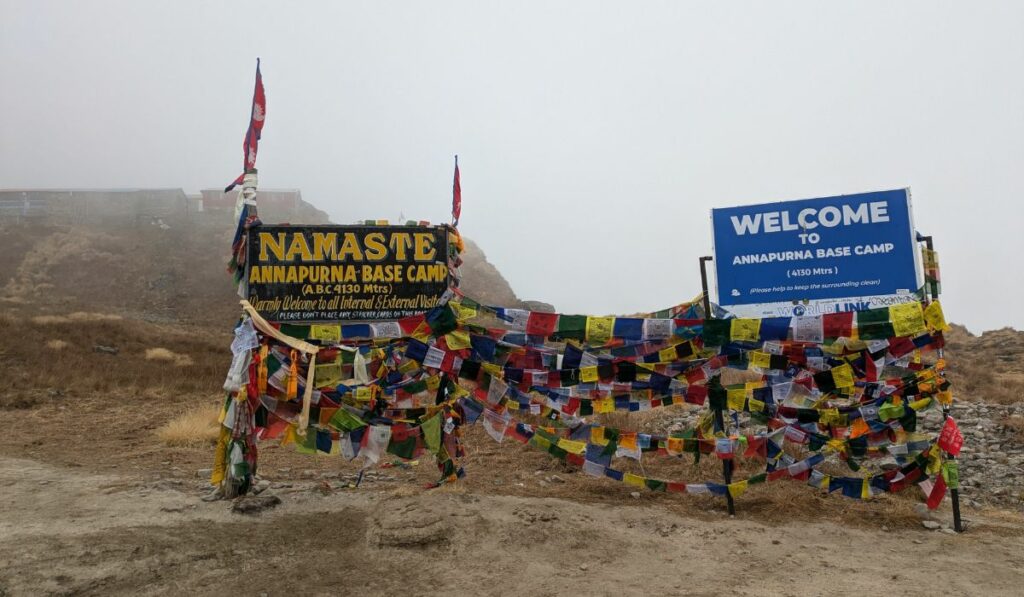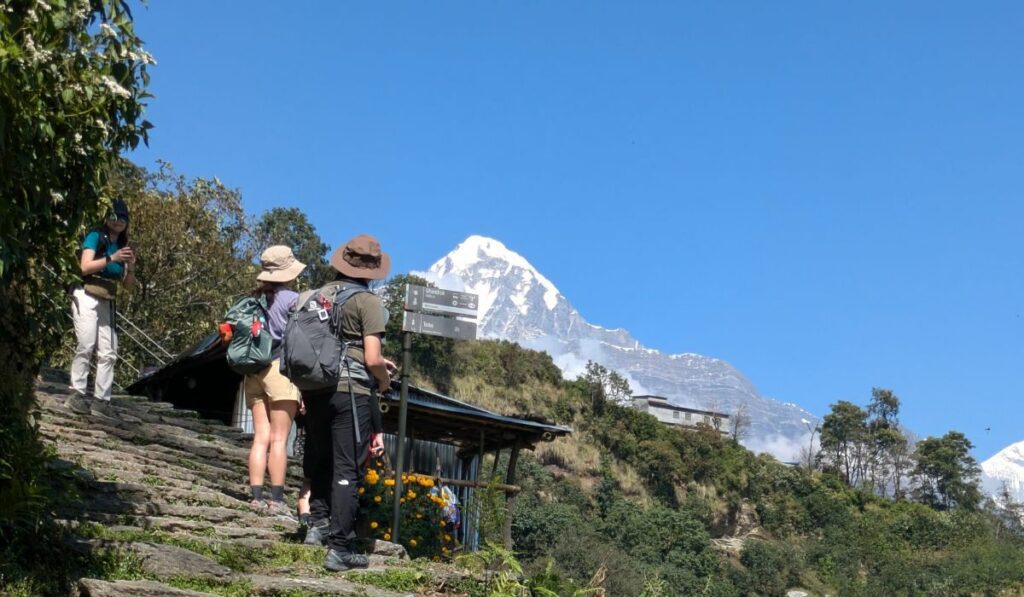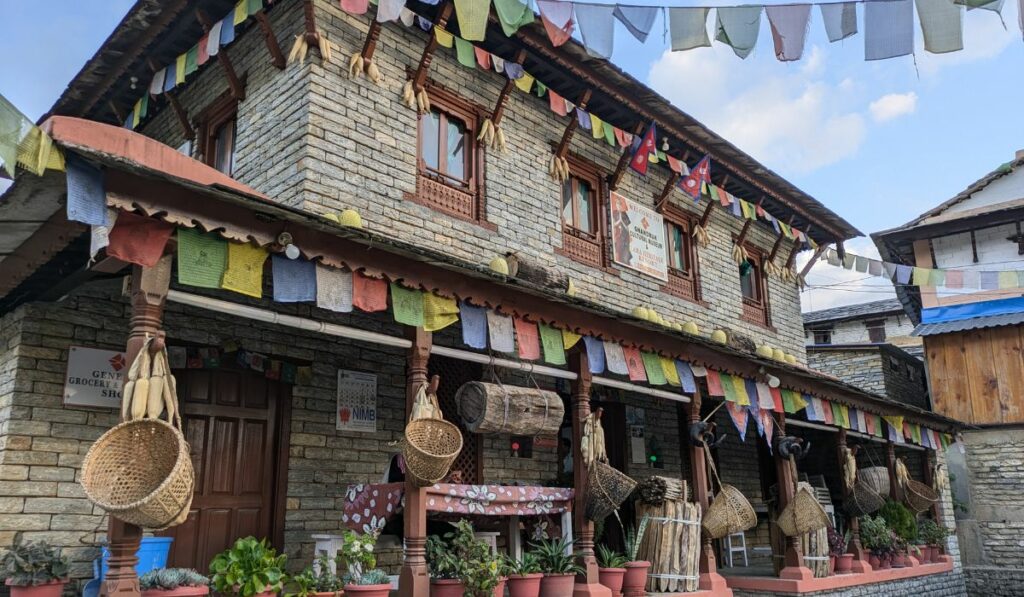Annapurna Base Camp is one of the most popular treks in Nepal, that will make your Himalayan adventure a once-in-a-lifetime experience. The trek takes you to an altitude of 4,130 meters, right into the heart of the Annapurna Sanctuary. This height lets you see a close-up view of towering peaks like Annapurna I, Machhapuchhre, Hiunchuli, and Gangapurna. Due to its moderate difficulty and scenic diversity, ABC trekking attracts both beginners and seasoned hikers. You will walk through rhododendron forests, terraced fields, and charming Gurung and Magar villages. This continuous change in landscape keeps each day exciting and different from the last.
What also makes the ABC trek route special is its rich culture and warm local hospitality. Villages like Chhomrong and Ghandruk welcome you with traditional food and cosy teahouses. Along the way, you get the chance to learn about mountain life and connect with local people. Whether you are looking for a solo journey or a group adventure, this Annapurna Base Camp guide gives you everything you need to plan. From altitude awareness to scenic highlights, this article is your reliable ABC trekking guide for 2025 and beyond.
ABC Trekking in 2025/2026: What Makes It Special?
- Spring brings fresh rhododendron blooms, adding bursts of colour to the forest trails.
- Autumn offers crystal-clear skies and ideal weather for capturing panoramic Himalayan views.
- The trail passes through bamboo, oak, and alpine forests, making each day’s walk visually different.
- Peaceful rivers and waterfalls line sections of the ABC trekking route, offering calming rest points.
- Local teahouses in every village provide hot meals, simple comfort, and the chance to connect with locals.
- Gurung and the Magar communities welcome trekkers with cultural warmth and stories passed down the generations.
- Solar-powered lodges and eco-practices make ABC trekking more sustainable each year.
- Shorter trekking itineraries and heli-return options now offer more flexibility for time-bound travellers.
- Improved trail conditions and clear signage make the ABC trek route easier for first-time hikers.
- Off-season months are gaining popularity for quieter trails and budget-friendly teahouse stays.
Journey to Annapurna Base Camp: Trek Routes & Itinerary Options

The classic journey to Annapurna Base Camp usually begins in Nayapul and ends at the same point or in Jhinu Danda. From start to finish, the ABC trekking route takes you through picturesque villages, forested trails, and high-altitude landscapes. Trekkers often choose between longer routes via Ghorepani–Poon Hill and shorter direct trails through Chhomrong. The longer itinerary adds extra views and acclimatization days, while the shorter one saves time without missing the core experience. For those short on time or seeking luxury, helicopter tours from Pokhara to base camp are gaining popularity. Some trekkers also hike up and return by heli, perfect for experiencing both adventure and comfort. Whether you pick a 7-day trek, a 12-day route, or a heli escape, every option offers a unique way to explore the beauty of Annapurna.
Short Itinerary for Annapurna Base Camp Trek

The short Annapurna Base Camp Route is one of the most popular trekking routes for those heading to ABC. It lasts for 5 days and takes you to Jhinu Danda, Lower Sinwa, Upper Sinwa, Deurali and Annapurna Base Camp. The itinerary of this short trek is:
Day 1: Drive to Jhinu Danda via Nayapul and Trek to Lower or Upper Sinwa
Day 2: Trek from Sinwa to Deurali
Day 3: Trek from Deurali to Annapurna Base Camp (via Machhapuchhre Base Camp)
Day 4: Return from ABC to Upper Sinwa
Day 5: Trek from Sinwa to Jhinu Danda and Drive Back to Pokhara
Standard 7 Days Itinerary for Annapurna Base Camp Trek
What makes this itinerary of Annapurna Base Camp Trek different from the short itinerary is you will have more time to acclamatize. The itinerary of this trek is:
Day 1: Drive from Pokhara to Jhinu Danda (1,780 m / 5,839 ft) and trek to Chhomrong (2,170 m / 7,120 ft)
Day 2: Trek from Chhomrong to Dovan (2,600 m / 8,530 ft)
Day 3: Trek from Dovan to Deurali (3,200 m / 10,498 ft)
Day 4: Trek from Deurali to Annapurna Base Camp (4,130 m / 13,549 ft)
Day 5: Trek from ABC to Bamboo (2,310 m / 7,578 ft)
Day 6: Trek from Bamboo to Jhinu Danda (1,780 m / 5,839 ft)
Day 7: Drive back from Jhinu Danda to Pokhara (822 m / 2,697 ft)
Other Routes for Annapurna Base Camp Trek
Instead of walking throughout the journey, there are also some other ways by which you can enjoy the scenic views of the Annapurna Base Camp. Options like shorter trekking routes, heli tours, heli return tours or even jeep rides to accessible points offer more flexibility.
ABC Heli Tour
The Annapurna Base Camp Heli Tour is perfect for travellers who want to witness the Himalayas without trekking for days. This tour takes you from Pokhara directly to ABC in under 30 minutes, offering a bird’s-eye view of snow-capped peaks, deep valleys, and alpine landscapes. It’s a luxury experience that suits those with limited time or physical constraints. You’ll land at the base camp, spend time soaking in the views, and fly back with unforgettable memories, all within a few hours.
- Pick Up
- Stop at Pokhara Domestic Airport
- Drop Off
Annapurna Base Camp Heli Return
The Annapurna Base Camp Heli return option is ideal for trekkers who want to hike up but prefer not to descend on foot. After reaching the base camp, you can take a scenic helicopter flight back to Pokhara. This option not only saves time but also helps avoid knee strain and steep descents. It’s a smart choice for those blending adventure with convenience while still completing the core trekking experience.
Day 1: Drive from Pokhara to Tikhedhunga and trek to Ulleri (2,050 m / 6,725 ft)
Day 2: Ulleri to Ghorepani (2,860 m / 9,383 ft)
Day 3: Ghorepani to Poon Hill (3,210 m / 10,531 ft) and trek to Chuile (2,310 m / 7,578 ft)
Day 4: Chuire to Upper Sinuwa (2,360 m / 7,742 ft)
Day 5: Upper Sinuwa to Deurali (3,200 m / 10,498 ft)
Day 6: Deurali to Annapurna Base Camp (4,130 m / 13,549 ft)
Day 7: ABC to Heli Return to Pokhara
Budget Guide for ABC Trek: Costs, Money-Saving Tips & Hidden Expenses
Planning the trek budget for ABC is essential to avoid surprises during your journey. While the Annapurna Base Camp trek is considered affordable compared to other Himalayan adventures, costs can add up without proper planning. Factors like route choice, accommodation, food, permits, and transportation directly impact your budget. Being aware of hidden expenses and knowing smart saving tips helps you enjoy the trek without overspending. Let’s break it down.
Costs
| Expense Category | Estimated Cost (Per Person) |
| TIMS Card & Permits | NPR 6,000 – NPR 7,000 (Approx. USD 50 – 55) |
| Guide (Optional) | USD 25 – USD 30 per day |
| Porter (Optional) | USD 20 – USD 25 per day |
| Accommodation | USD 5 – USD 10 per night in teahouses |
| Meals (3 times daily) | USD 20 – USD 30 per day |
| Transport (Pokhara side) | USD 50 – USD 80 round trip (jeep/bus) |
| Miscellaneous | USD 5 – USD 10 per day (charging, Wi-Fi, hot water) |
| Total Estimated Budget | USD 500 – USD 700 for a 7-10 day trek |
Money Saving Tips
- Trek in groups to share guide and porter fees.
- Use public buses instead of private jeeps where possible.
- Bring your own snacks and water purification tablets to cut down food costs.
- Avoid bottled water purchases; refill boiled or filtered water from teahouses.
- Book lodges directly on the trail instead of through agencies for lower prices.
- Carry enough cash from Pokhara, as ATMs are rare on the trail and charge high fees.
- Negotiate accommodation rates if you eat meals at the same teahouse.
- Skip luxury add-ons like hot showers or Wi-Fi daily to save small but frequent costs.
- Join fixed departure groups to split overall trekking expenses.
- Travel in shoulder seasons for lower lodge rates and flight discounts.
Hidden Expenses
| Hidden Cost | Details |
| Hot Showers | USD 2 – USD 3 per use in teahouses |
| Charging Electronics | USD 2 – USD 3 per hour |
| Wi-Fi Access | USD 3 – USD 5 per day |
| Boiled Drinking Water | USD 1 – USD 2 per liter |
| Tips for Guides/Porters | USD 5 – USD 10 per day (customary but optional) |
| Emergency Evacuation | It can cost USD 2,000+ without insurance |
| Extra Snacks/Drinks | USD 5 – USD 10 per day for tea, coffee, energy bars |
Permits & Regulations for Annapurna Base Camp
Before starting your Annapurna Base Camp trek, obtaining the required permits is mandatory. These permits help maintain the region and ensure your safety throughout the journey. Let’s look at the essential permits you need and how you can save costs while getting them.
Required Permits
- TIMS Card (Trekkers’ Information Management System)
- Cost: USD 15 (Approximately NPR 2,000 ) for individual trekkers.
- Purpose: Helps in trekker safety and keeps a record of visitors.
- Cost: USD 15 (Approximately NPR 2,000 ) for individual trekkers.
- Annapurna Conservation Area Permit (ACAP)
- Cost: USD 22 (Approximately NPR 3,000) per person.
- Purpose: Funds conservation efforts and local development in the Annapurna region.
- Cost: USD 22 (Approximately NPR 3,000) per person.
Note: Both permits are checked at multiple points along the ABC trekking route. Carry originals and keep digital copies, too.
How to Save Cost on Permits
- Buy Permits Directly in Pokhara or Kathmandu:
Avoid middlemen or third-party agents who charge extra service fees. Get permits from the Nepal Tourism Board (NTB) offices. - Join a Group Trek Package:
If you’re trekking with an agency, permit costs are often included in the package. Sometimes, group rates offer small discounts. - No Hidden Taxes:
Check the latest official fees to avoid overpaying. Prices are usually fixed, but agents may add extra charges if you’re unaware. - Carry Valid IDs:
Always bring your passport and a few passport-sized photos. These are necessary for the permit process and will save you from last-minute photo expenses.
Note: Being informed about Annapurna Base Camp permits ensures you stay within budget while trekking legally and responsibly.
Ideal Time for ABC Trekking: Seasons, Months & Weather

The ideal season is key for a memorable Annapurna Base Camp trek. Each time of year offers different experiences in terms of weather, visibility, and trail conditions. While ABC trekking is possible almost year-round, certain months stand out for their clear skies, safe trails, and breathtaking mountain views. Let’s explore the best times to plan your journey.
Spring (March to May)
Spring is the most popular season for ABC trekking. The weather stays mild, with temperatures ranging from 10°C to 20°C at lower altitudes. Rhododendron forests bloom beautifully, adding vibrant colours along the ABC trek route. The skies remain clear, offering unobstructed views of Annapurna, Machapuchare, and Dhaulagiri. However, expect more crowds and slightly higher costs.
Autumn (September to November)
Autumn is another peak season for the Annapurna Base Camp trek. Post-monsoon, the weather becomes stable with crisp air and crystal-clear visibility. Daytime temperatures range from 10°C to 18°C, while nights get colder at higher altitudes. This period is perfect for trekkers seeking the best panoramic mountain views and reliable trail conditions.
Winter (December to February)
Winter brings a quieter trekking experience with fewer crowds. Daytime temperatures are manageable, but nights can drop below freezing, especially near ABC. Snowfall at higher elevations adds a magical touch but can block certain parts of the trail. It’s suitable for experienced trekkers who enjoy solitude and can handle cold-weather challenges.
Monsoon (June to August)
Monsoon is the least preferred time for ABC trekking. Heavy rains make trails slippery, and landslides are common. Cloud cover often blocks mountain views. However, it’s the best time for those who want lush green landscapes and can handle wet conditions. Trekking during this time requires extra caution and good waterproof gear.
Packing List for ABC Trek: Essentials & Pro Tips
Packing smartly is crucial for a comfortable and safe ABC trek. Since you’ll face varied weather conditions, from warm valleys to cold base camp nights, your gear should be versatile yet lightweight.
Clothing Essentials
- Moisture-wicking base layers (tops & bottoms)
- Insulating mid-layers (fleece or down jacket)
- Waterproof & windproof outer shell (jacket & pants)
- Comfortable trekking pants and T-shirts
- Warm hat, gloves, and buff or scarf
- UV-protection sunglasses and sun hat
- Thermal innerwear for colder nights
- Extra socks and underwear
Footwear & Accessories
- Sturdy, broken-in trekking boots
- Lightweight camp shoes or sandals
- Trekking poles for stability
- Waterproof gaiters (optional for snow/mud)
- Headlamp with extra batteries
- Durable backpack (30-40L for the trek)
- Rain cover for backpack
Sleeping & Personal Care Items
- Warm sleeping bag (rated to -10°C or lower)
- Quick-dry towel and biodegradable soap
- Sunscreen (SPF 50+) and lip balm
- Personal first aid kit with altitude sickness medicine
- Water purification tablets or portable filter
- Wet wipes, tissues, and hand sanitizer
- Lightweight thermos for hot drinks
Gadgets & Miscellaneous
- Power bank and extra charging cables
- Camera or smartphone for capturing memories
- Lightweight snacks (energy bars, nuts, chocolates)
- Copies of permits, insurance, and ID
- Small cash in NPR for tea houses & small shops
Safety Guide & Altitude Sickness on ABC Trek
Trekking to Annapurna Base Camp is an unforgettable adventure, but it comes with challenges, especially related to safety and altitude. Understanding potential risks and knowing how to stay safe ensures a worry-free experience.
Altitude Sickness: Know the Risks
The ABC trekking route reaches up to 4,130 meters, where altitude sickness becomes a real concern. Symptoms like headaches, nausea, dizziness, and shortness of breath can appear if you ascend too quickly. In severe cases, it can lead to Acute Mountain Sickness (AMS), which requires immediate descent.
Ways to Prevent Altitude Sickness
- Ascend gradually and follow acclimatization guidelines.
- Stay hydrated by drinking 3-4 liters of water daily.
- Avoid alcohol and smoking during the trek.
- Listen to your body and take rest if needed.
- Carry Diamox (Acetazolamide) after consulting your doctor.
- Trek with a certified guide familiar with altitude issues.
Safety Tips to Follow While on ABC Trek
- Hire a Local Guide & Porter: They ensure you follow safe trails and help during emergencies.
- Carry a First Aid Kit: Include medicines for AMS, colds, fever, sprains, and blisters.
- Stay Updated on Weather Forecasts: Sudden snowfalls or heavy rain can make trails dangerous.
- Start Early, End Before Dark: This reduces the risk of getting lost or injured.
- Get Travel Insurance: Ensure it covers high-altitude rescue and medical emergencies.
Cultural Insights: Villages & People Along the Trail

The Annapurna Base Camp trek is not just about majestic mountains; it’s also a cultural journey through diverse villages. As you walk through the ABC trek route, you’ll encounter warm-hearted locals, ancient traditions, and unique lifestyles.
Traditional Villages on the ABC Trekking Route
Villages like Ghandruk, Chhomrong, and Sinuwa showcase the traditional Gurung and Magar cultures. These communities are known for their bravery and being part of the famous Gurkha soldiers. Their stone-paved paths, slate-roofed houses, and monasteries reflect a rich heritage.
Further along, settlements like Deurali and Bamboo offer a more remote experience, where daily life revolves around farming and trekking tourism. The interaction with locals here feels more personal, giving you a glimpse into simple mountain living.
Local Hospitality & Culture
Villagers welcome trekkers with genuine smiles and traditional greetings. You’ll often hear “Namaste” as you pass by. Many teahouses are family-run, providing not just meals but stories of their connection to the Himalayas.
Festivals like Dashain and Tihar bring vibrant energy to the trail. If you trek during these times, you’ll witness colourful decorations, music, and cultural rituals.
Responsible Trekking & Cultural Respect
Always ask before taking photos of locals or religious sites. Dress modestly, especially in villages and temples. Simple gestures like buying local products or eating at village-run teahouses support the local economy. Embracing these cultural aspects will make your Annapurna Base Camp guide experience richer, connecting you not just to nature but to the heart of the Himalayas.
Book Your Trip with Mountain Routes
Planning your Annapurna Base Camp trek? Let Mountain Routes handle the details while you focus on the adventure. With experienced local guides, personalized itineraries, and a strong focus on safety, we ensure your journey is smooth, memorable, and hassle-free. Our transparent pricing means no hidden costs, while every trip you book helps support the local communities along the trail. Whether you seek a relaxed trek or an adrenaline-packed challenge, Mountain Routes crafts the perfect Himalayan experience for you. Book your Annapurna Region trek with us and turn your dream adventure into a reality.